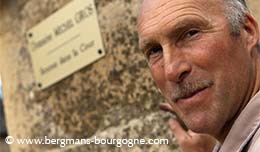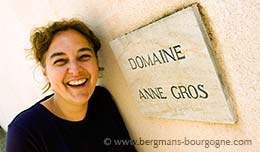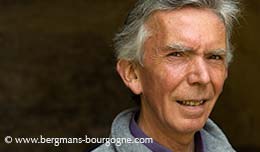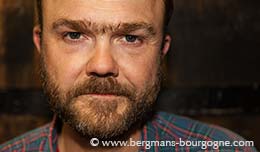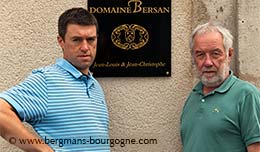
n Volnay, at Domaine Jean-Marc Bouley, you can taste your way from the bottom of the slope to the top. From the Bourgogne rouge down on the plains, via the village appellation Volnays and the premier crus, up to the Bourgogne Hautes-Côtes de Beaune. From the vineyards down below up to the top there is a difference in altitude of roughly 100 metres.
– The difference in altitude means we harvest the Hautes-Côtes de Beaune a week later than the Bourgogne, explains Thomas Bouley.
 The domaine is run by Thomas Bouley. His father Jean-Marc retired in 2012 and left the eight and a half hectares to his son. It was Jean-Marc Bouley who during the 1980’s extended the domaine and started bottling 100 per cent of the production. At most the domaine covered 17 hectares.
The domaine is run by Thomas Bouley. His father Jean-Marc retired in 2012 and left the eight and a half hectares to his son. It was Jean-Marc Bouley who during the 1980’s extended the domaine and started bottling 100 per cent of the production. At most the domaine covered 17 hectares.
– I’m the fourth generation of winemakers, says Thomas Bouley. Before my father they only had a few hectares and most of the production was sold off as grapes. Just a few bottles were made back then.
Much of those 17 hectares were vines in regional appellation. It was difficult to make enough money off them, so eventually they decided to sell much of it and concentrate on Volnay, Pommard and Beaune. This is also the part of the Côte d’Or, which in recent years has been badly hit by miserable weather conditions. The average yield at Domaine Jean-Marc Bouley was 28 hl/ha in 2010, 33 hl/ha in 2011, 14,5 hl/ha in 2012 and 20 hl/ha in 2013.
– The only white we have today is the Bourgogne Aligoté, says Thomas Bouley. We produce very small quantities of Meursault and Bourgogne blanc, but those wines are bought in as must. We do the ageing and bottling. Just two or three barrels.
 Despite being regional appellations both the Bourgogne rouge and the Bourgogne Hautes-Côtes de Beaune of Domaine Jean-Marc Bouley come from vines in Volnay.
Despite being regional appellations both the Bourgogne rouge and the Bourgogne Hautes-Côtes de Beaune of Domaine Jean-Marc Bouley come from vines in Volnay.
– Our Bourgogne rouge comes from vines in Longbois, which is actually west of the road from Beaune to Chalon-sur-Saône, says Thomas Bouley. Usually in the Côte d’Or you’ll find the regional appellation below the road, but that’s not the case here. We also have a small parcel in Petit Pret. On average the vines are 40 years old. Lonbois has very good soil for Bourgogne. It is well-drained and not particularly deep soil. Volnay Cros Martin, village appellation, is just above. There the soil is heavier, with more clay. They produce different wines, but I think Longbois is better.
 Thomas Bouley uses the same winemaking for both the Bourgogne rouge and the Bourgogne Hautes-Côtes de Beaune. Both are aged in barrels, but no new oak. He wants to bring out the fruit and the pleasure; wines for early drinking. The Hautes-Côtes vineyard is located at the very top of the slope, just above Volnay, where it is practically flat.
Thomas Bouley uses the same winemaking for both the Bourgogne rouge and the Bourgogne Hautes-Côtes de Beaune. Both are aged in barrels, but no new oak. He wants to bring out the fruit and the pleasure; wines for early drinking. The Hautes-Côtes vineyard is located at the very top of the slope, just above Volnay, where it is practically flat.
– Up there you have beautifully red soil, says Thomas Bouley. It’s poor soil, with lots of stones. Not very deep. Very mineral, which shows in the glass. There is a small parcel of ten-year-old vines. The rest are up to 55 years old.
 There are three different village appellation Volnays at Domaine Jean-Marc Bouley – a straight Volnay, an old vines cuvée and the Volnay Clos de la Cave, which comes from vines just behind the domaine.
There are three different village appellation Volnays at Domaine Jean-Marc Bouley – a straight Volnay, an old vines cuvée and the Volnay Clos de la Cave, which comes from vines just behind the domaine.
The straight Volnay is a blend of six different parcels, from all over the appellation.
– They are very different in terms of soil, explains Thomas Bouley. Blending is very interesting. The plots at the bottom of the slope have a lot more clay and they bring generosity to the wine. Further up the slope there are plots with more white soil. In the wine this produces something very mineral from mid palate to the finish. So in this case blending makes a better wine than making different cuvées.
Thomas Bouley finished wine school in 2002. Before returning to the family domaine he completed several internship, both in Burgundy and abroad.
 – I went to the Willamette Valley in Oregon, he says. I did my internship at the Witness Tree Vineyard, which is right next to Cristom Vineyards. In 2004 I worked a Domaine des Epeneaux in Pommard. In 2005 I went to New Zealand and Felton Road. I also worked in Jadot’s barrel cellar and with Jean-Pierre Diconne in Auxey-Duresses and Jean-Luc Joillot in Pommard.
– I went to the Willamette Valley in Oregon, he says. I did my internship at the Witness Tree Vineyard, which is right next to Cristom Vineyards. In 2004 I worked a Domaine des Epeneaux in Pommard. In 2005 I went to New Zealand and Felton Road. I also worked in Jadot’s barrel cellar and with Jean-Pierre Diconne in Auxey-Duresses and Jean-Luc Joillot in Pommard.
The Clos de la Cave is located just behind the winery, quite high up on the Volnay slope. The soil is deep, stony and well-drained. The grapes usually ripen later here. For the wine 40 per cent of whole bunches are used.
– This is exactly what you have in mind when you think of Volnay, says Thomas Bouley. Elegant, with silky tannins. The whole bunches we use come from the oldest part. Small berries with big concentration.
 – Whole bunches is very much the fashion at the moment. Everybody wants to use it. But it’s not a new technique. On the contrary, it’s old.
– Whole bunches is very much the fashion at the moment. Everybody wants to use it. But it’s not a new technique. On the contrary, it’s old.
He adds with an ironic smile:
– It’s so easy. Just use whole bunches and you will make a great wine.
– For me, the best wine is with whole bunches. But the worst wine is also with whole bunches. You have to find the balance. If you have any doubts, don’t use whole bunches.
Domaine Jean-Marc Bouley produces five premier crus – two in Pommard – Les Fremieres and Les Rugiens – and three in Volnay – Les Carelles, Caillerets and Clos des Chênes.
– If we look at the three Volnay premier crus, the soil is really different in each of them. At the bottom of the slope you have Les Carelles. Beautiful red soil. Underneath you have big chalky rocks. That’s what makes Les Carelles special. Caillerets is a bit higher up on the slope, with many flat stones, laves, in the soil. Clos des Chênes is higher up. It’s very windy up there. It is cooler, so the grapes ripen later. Much more clay, with the mother rock beneath.
– But Les Carelles is my baby. It is grand cru to me. It is not well-known, because it is small and split between many owners. Many blend it with grapes from other premier crus to make Volnay premier cru.
© 2014 Ola Bergman










